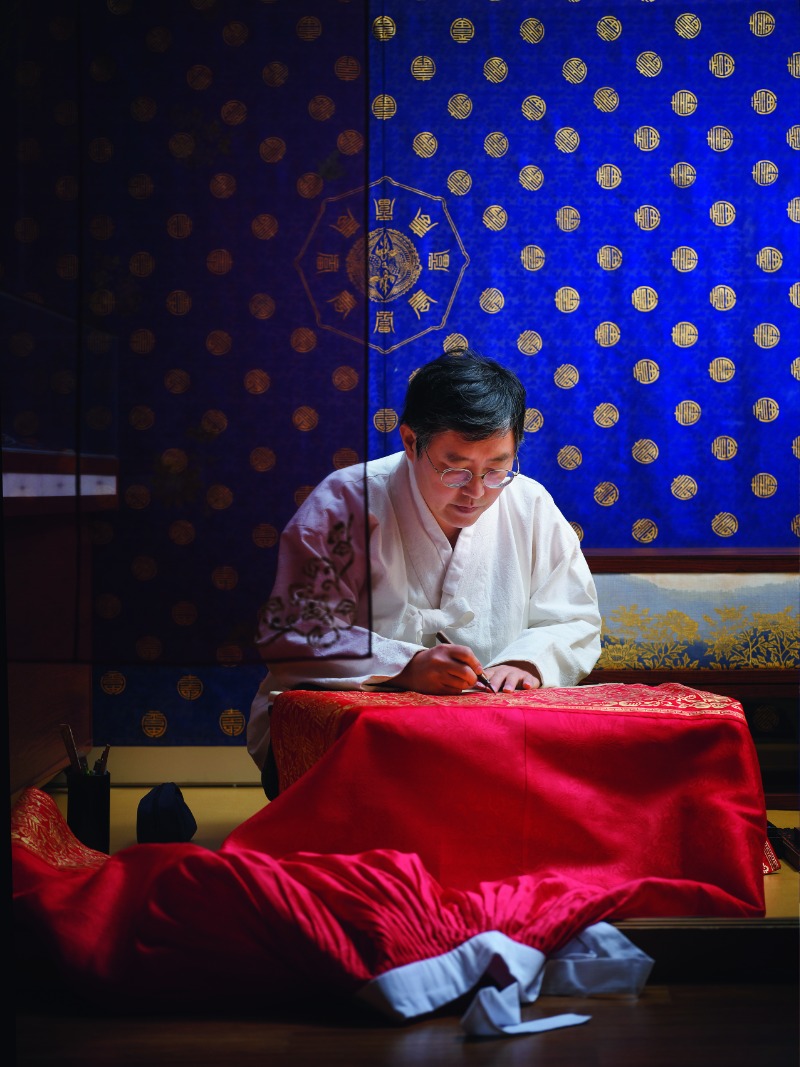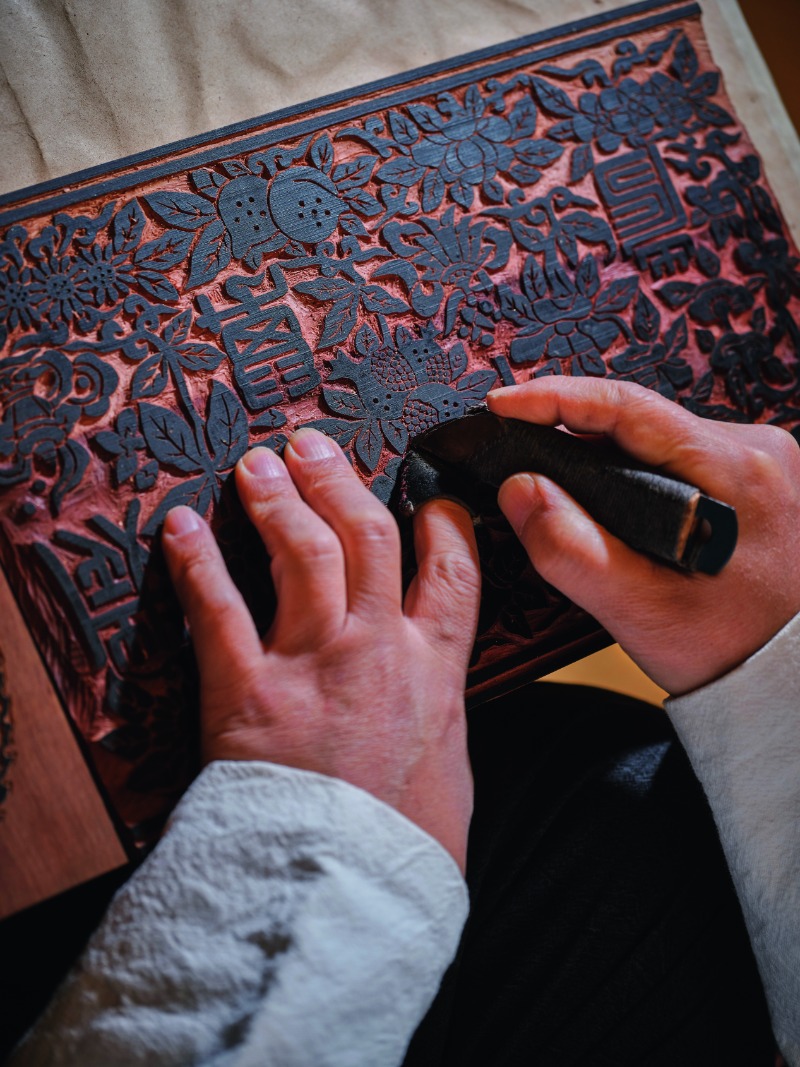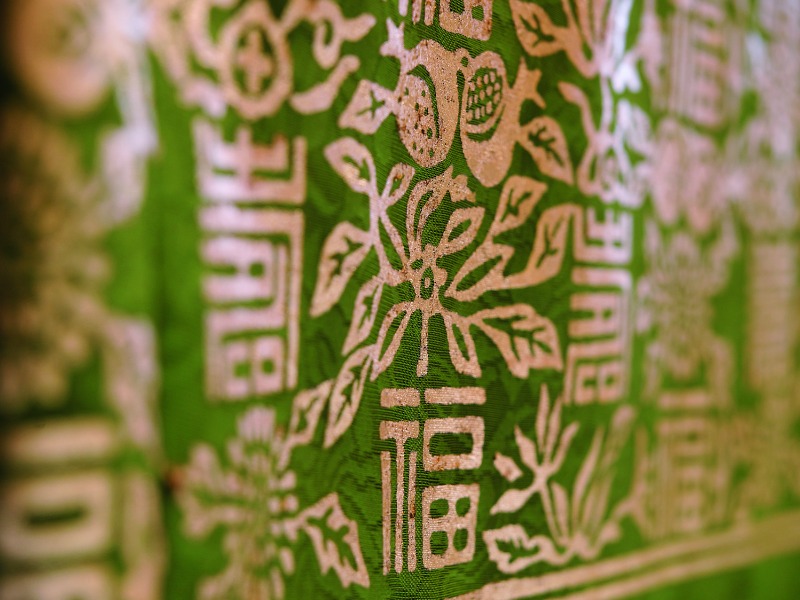In Gahoe-dong, Seoul, where traditional Korean houses are clustered, the narrow alleys are studded with traditional craft workshops. One of them is Kum Bak Yeon (meaning “a feast of gold leaf”), run by Kim Gi-ho, title holder of National Intangible Cultural Heritage No. 119. Korea’s sole master artisan of gold leaf imprinting, Kim carries on the craft that has been handed down in his family for five generations.

Kim Gi-ho removes stray bits of gold leaf to define the outlines of golden patterns on the hem of an ample skirt. The seemingly simple process of gold leaf imprinting requires delicate skills and intense concentration.
Kim Gi-ho’s workshop is like a small exhibition hall showcasing the past and present of gold leaf craft. An array of ceremonial clothes, hair ribbons (daenggi), bridal headpieces (jokduri), and draw pouches (bokjumeoni) offers a glimpse into the splendor of traditional Korean clothing, and a collection of daily articles like neckties, jewelry boxes, and brooches exemplifies modern applications of the traditional craft.
“Gold has long been associated with grandeur and authority because it is precious, the color and luster unchanging with time. Gold was used sparingly even in the court of the Joseon Dynasty. Not everyone could wear clothes adorned with gold leaf,” Kim explained.
As he spoke, he pointed to a replica of the green ceremonial robe (wonsam) that Princess Deogon, the third daughter of King Sunjo (r. 1800–1834), wore at her wedding. Indeed, gold leaf imprinting was used exclusively for royal costumes to imbue them with dignity and glory. Even in the royal family, motifs such as dragons, phoenixes, and flowers were used discriminately based on the wearer’s status. However, the rules were eased toward the latter part of the Joseon era to allow commoners to wear clothes decorated with gold leaf on special occasions, such as weddings, a child’s first birthday (dol), or a sixtieth birthday (hoegap).
Skills and Creativity

Kim carves intricate patterns drawn on a woodblock. To make the pattern blocks, he uses sand pear wood dried for over five years as the wood is both hard and easily carved.
Gold leaf is obtained by beating gold into paper-thin sheets. In the Joseon era, there were separate artisans who specialized in producing gold leaf itself (geumbakjang) and in imprinting patterns with gold leaf (dodaikjang or bugeumjang). With the start of mechanical gold leaf production in the early modern period, however, the process of goldbeating became obsolete. Over time, people came to identify gold leaf with golden patterns, and the term geumbakjang now refers to artisans who decorate fabric with gold leaf designs.
The process of gold leaf imprinting may sound rather simple: A woodblock engraved with a pattern is coated with glue, the pattern is stamped onto fabric, and gold leaf is pressed onto the pattern. Notwithstanding the succinct description, each step requires the utmost concentration and patience. First, the wood for the woodblocks must be dried for over five years to prevent warping. Kim uses sand pear wood (Pyrus pyrifolia), which is hard but easy to carve. The boards are soaked for two minutes in boiling water with added soybean oil, and then dried in a shady, airy place. The procedure is repeated multiple times to fashion pattern blocks that are resistant to warping. When sufficiently dry, the boards are planed and sanded smooth.
The next step is the engraving. Patterns are drawn onto the board and then carved in relief. It is important to emboss the design in a way that the edges are slanted, so that any glue spilling into the grooves can be easily removed. Gold leaf is attached using fish glue, made by boiling dried croaker bladders in water for many hours. A natural glue with superior adhesive strength, fish glue was not only used to make clothing and handicrafts in the court but also to cook gourmet dishes. When the glue is brushed onto the engraved surface of a woodblock, the most important point is to maintain the right consistency. If it is too thick, the gold leaf will crinkle, and if too light, it will come loose, rendering the pattern incomplete.
The glued woodblock is stamped onto a piece of fabric in the same way a seal is stamped onto paper. Gold leaf is then attached to the glued parts of the fabric, tapped lightly with dry fingertips. This part must be done quickly and precisely before the glue dries. The fabric is left to dry, and any bits of gold leaf clinging to the blank parts of the pattern are gently removed to define the outlines. Attaching gold leaf requires dexterity, while designing and arranging patterns calls for great creativity.
“The Chinese and Japanese value symmetrical patterns in their gold leaf craft. They find beauty in exact proportion and balance. Koreans, on the other hand, find asymmetry natural and beautiful. I think of this as the difference between digital and analog,” Kim said.
While working on a project, Kim spends the greater part of his time creating patterns. He needs to decide in advance what patterns will be used and how they will be arranged. “The patterns used for gold leafing have changed with time, reflecting the social atmosphere. It’s my belief that pattern design should also evolve to communicate with the time it belongs to. Besides, the same motif can feel different depending on how it is designed and expressed,” he said.
Advanced Technology from the Past
Kim is the fifth-generation successor of a family business that began with his great-great-grandfather, who supplied fabric products to the royal family during King Cheoljong’s era (r. 1849– 1864). At the time, gold leaf was mostly ordered from China. As delivery delays caused a lot of trouble, his ancestor started to produce it himself. The craft of goldbeating was passed down to his grandfather, but now only the orally transmitted instructions remain.
“My grandfather also worked in the royal palace, just like his father and grandfather before him. I heard that he was in charge of decorating the clothes of the last crown princess of the Korean Empire, and of Princess Deokhye, the youngest daughter of Emperor Gojong,” Kim recalled.
In 1973, when Kim was five years old, gold leaf imprinting was designated a National Intangible Cultural Heritage, with his grandfather the first title holder of the craft. Months later, however, his grandfather died from a chronic illness, and the craft was excluded from the heritage list for the lack of a successor.
“At the time, my father had his own job while doubling as a trainee in my grandfather’s workshop. He quit his job immediately after my grandfather passed away and committed himself to the traditional craft. When my father’s health deteriorated, I also quit my job and became a full-time artisan. I suppose this way of life is some sort of family tradition,” he said.
In 2006, when gold leafing regained its heritage designation, his father Kim Deok-hwan became the first holder of the title. In 2018, just before his father passed away, Kim was also awarded the same recognition.
For four years after graduating from college, Kim had worked at Samsung Electronics as an engineer and designer of robots. The decision to resign could not have been easy. But sense of duty aside, Kim felt he was not suited to the corporate life. “While there were other capable engineers who could replace me in the company, my family’s craft would have been lost if I had not taken it on. I was convinced of its future business potential as well. When I started working in earnest, I realized that designing robots and handling gold leaf thinner than a micrometer — or 1/10,000 millimeters — were not that different. A single gold leafis about 0.1 μm, and it is a kind of high tech to produce gold leaf, demonstrating that such an advanced technology was already developed in the distant past,” he said.
The first thing Kim did after leaving the company in 1997 was tohis own website. He was quite ahead of the time as the internet had just become widespread in Korea. He planned to offer online sales and promote his works outside of Korea, but then the Asian financial crisis broke out that very year.
“Our income was zero for the first three months. Fortunately, we were able to survive thanks to long-time customers who continued to order our products for their children and grandchildren living abroad. Things are much better now. Aside from orders for gold leaf imprinting, we develop and merchandise our own cultural products under the workshop brand,” he said.
A Family of Artisans

Gold leaf patterns are both beautiful and symbolic. Commonly used auspicious symbols include the characters meaning a long life (壽) and a happy life (福), as well as symbols for fecundity (pomegranate), wealth and prosperity (peony), and many other blessings.
A family running a cottage industry is bound to become a craft community because the work cannot be carried out by one person alone.
“I was able to carry on and develop our family business because other artisans like my grandmother and mother were by my side. My wife has also worked with me all the time, so close by that I feel like she’s my double,” Kim said.
Park Soo-young, Kim’s wife, was recognized as a certified trainee of gold leaf craft in 2009, and their son, who majored in animation in college, is also helping out. Park was selected as Artisan of the Year in 2022 by the YÉOL Korean Heritage Preservation Society, an organization dedicated to supporting both established and emerging artisans of traditional Korean crafts, and her works were highly acclaimed at a project exhibition held in collaboration between YÉOL and Chanel, the French luxury fashion house.
“There is a renewed interest in gold leaf craft as a balanced combination of traditional beauty and modern sensibilities. It is an art that evokes dreams, and its designs reflect people’s wishes for honor, wealth, love, and other blessings,” Kim said.
Kim also has a dream — to establish a gold leaf craft museum. Perhaps that is why he has grown even more committed to his work lately.